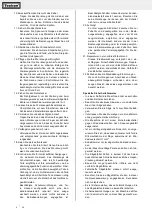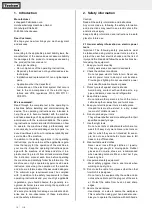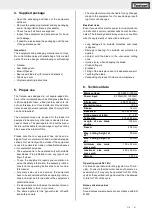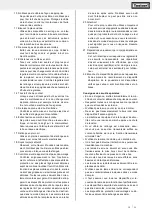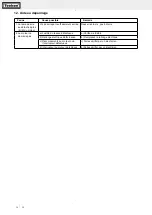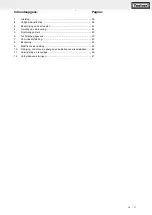
22
GB
Wear ear-muffs.
The impact of noise can cause damage to hearing.
Sound pressure level L
pA
:
66,9 dB(A)
Uncertainty K
pA
:
3 dB(A)
Sound power level L
WA
:
79,9 dB(A)
Uncertainty K
WA
:
3 dB(A)
The quoted values are emission values and not nec-
essarily reliable workplace values. Although there is
a correlation between emission and immission levels
it is impossible to draw any certain conclusions as
to the need for additional precautions. Factors with
a potential influence on the actual immission level
at the workplace include the duration of impact, the
type of room, and other sources of noise etc., e.g.
the number of machines and other neighboring op-
erations. Reliable workplace values may also vary
from country to country. With this information the user
should at least be able to make a better assessment
of the dangers and risks involved.
Reduce noise generation and vibration to a minimum!
• Use only equipment that is in perfect condition.
• Maintain and clean the equipment regularly.
• Adopt your way of working to the equipment.
• Do not overload the equipment.
• Have the equipment checked if necessary.
• Switch off the equipment when not in use.
7. Before starting the machine
Important:
Always pull out the power plug before making adjust-
ments to the equipment.
7.1 General information
• All covers and safety devices have to be properly
fitted before the equipment is switched on.
• It must be possible for the blade to run freely.
• When working with wood that has been processed
before, watch out for foreign bodies such as nails
or screws, etc.
• Before you actuate the On/Off switch, make sure
that the saw blade is correctly fitted and that the
equipment’s moving parts run smoothly.
• Check that the voltage on the rating plate is the
same as your supply voltage before you connect
the equipment to the power supply.
• Only ever connect the equipment to a properly in-
stalled shock-proof socket which is protected by a
10A fuse as a minimum.
7.2 Installing the fretsaw on a workbench (Fig. 3, 4)
The unit may only be installed by a professional.
Required for installing (not provided):
• M6 hex screw (4x)
• M6 hex nut (8x)
• Washer, Ø 7 mm (4x)
• Flat gasket, Ø 7 mm (4x)
• Rubber base: 410 x 255 x 13 mm
The length of the screws to be used varies, depend-
ing on the thickness of the table top.
• Install the fretsaw on a work table made from solid
wood. This will avoid excessive noise caused by vi-
brations.
• Mark the drill holes. Use the fretsaw as a template
for this purpose.
• Drill 4 holes with a diameter of 9 mm into the work
table and the rubber base.
• Screw the fretsaw to the table using the mount-
ing points (Fig. 3 Item 16) and in the following se-
quence (Fig. 4):
A) Fretsaw
B) Rubber base
C) Work table
D) Flat gasket
E) Washer
F) Hex nut
G) Hex nut
H) Hex screw
• Tighten the hex nut (F) and secure it with a second
hex nut (G).
7.3 Assembly
Important! Always pull out the power plug before car-
rying out any maintenance or conversion work on the
fretsaw.
7.3.1 Mounting the saw blade guard and the saw-
dust blower facility (Fig. 6/7/8)
• Attention: Prior to the installation of the retaining
device (18), the pre-assembled saw blade (17) must
be dismantled as described in articel 7.3.2.
• Secure the retaining device (29) to the machine by
using the knurled screw (3). Attach the retaining de-
vice (18) to the bracket (29), as shown in the figure.
• Secure the saw blade guard (5) with the nut and
bolt.
• Mount the blow-off device (1) as shown in Figure 8.
7.3.2 Changing the saw blade (Fig. 1/9/10)
Important
To avoid injuries attributed to inadvertent startup: Al-
ways move the switch to the “0” position and pull the
power plug out of the socket outlet before removing or
changing the saw blade.
Removing the saw blade without pins (optional)
(Fig. 1+9+9.1+9.2+9.3+9.4)
Use the adapter (19/23) with flat saw-blades.
The distance results by the setting gauge (32).
The saw-blade is fixed with Allen screws.
• To remove the saw blade (17), lift the table insert
(26) upwards.
• First release the tension by lifting the clamping le-
ver (9) upwards. If required, further reduce the ten-
sion by turning it anti-clockwise.
• Slightly push down the outrigger (10).
• Then remove the sawblade by pulling it forward
out of the supports and through the access perfo-
ration in the table.
Summary of Contents for 3901403958
Page 2: ...2 2 3 11 12 13 14 15 30 31 1 1 10 9 6 2 3 4 5 7 26 22 8 16 10...
Page 110: ...110 BG 1 111 2 111 3 114 4 114 5 114 6 115 7 116 8 117 9 118 10 118 11 119 12 119...
Page 111: ...111 BG...
Page 113: ...113 BG 8 9 10 11 12 13 14 15 16 17 18 19 20 21 22...
Page 114: ...114 BG 1 2 VBG 7j...
Page 120: ...120 BG 10 2 1 1 8 8 25 30 10 2 2 10 3 5 30 C 10 4 11 2012 19 E 12 1 2 a a b b c c d d...
Page 221: ...221 RU 1 223 2 223 3 226 4 226 5 226 6 227 7 228 8 229 9 230 10 230 11 231 12 231...
Page 222: ...222 RU...
Page 224: ...224 RU 8 9 10 11 12 13 14 15 16 17 18 19 20 21...
Page 225: ...225 RU 22 1 2 VBG 7j...
Page 231: ...231 RU 2012 19 EU 10 4 11 12 1 2 a a b b c c d d...
Page 232: ...232...
Page 233: ...233...
Page 234: ...234...
Page 236: ...236...
Page 238: ...238...

